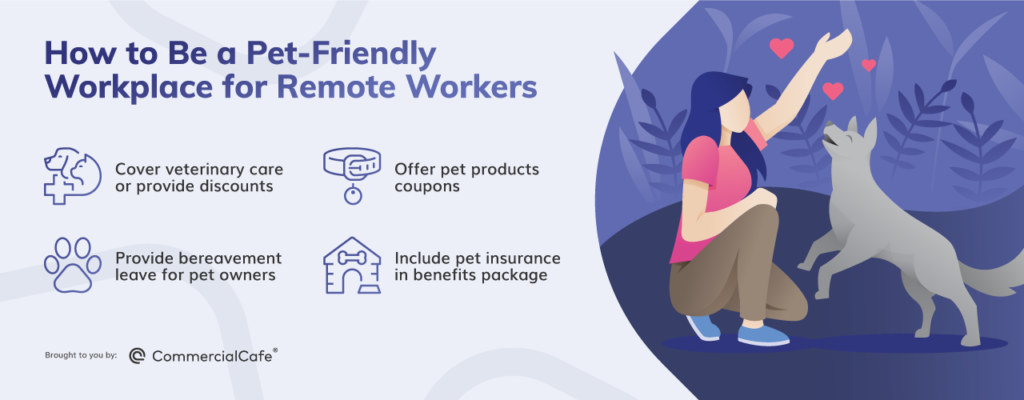For those fortunate enough to be able to work from home during the current lockdown, posts of pets as their owners’ “coworkers” have become part of the daily social media diet. And, while the last few weeks have been an unprecedented experiment in working from home, they’ve also been a test of the pros and cons of having pets around during working hours.
In general, employers are likely familiar with the humorous side of having pets in the “workplace.” From cats who decide to strut across a keyboard during a meeting to dogs vying for attention, there are certainly many benefits associated with animal companions. But, when it comes to future decisions about pet-friendly policies within a company, social media provides anecdotal evidence at best.
So, for those who are interested in a more structured review of the benefits of pet ownership and its possible influence on work, we went beyond the headlines to analyze some of the existing research papers related to pets in the workplace, their effect on productivity and any positive health benefits for their owners.
As a result, this overview highlights the findings of psychologists, zoologists and human resource experts in research published between 2016 and 2019. For more details and links to these studies, access our Sources section.
Most People Underestimate Material Costs Related to Pets
Since the start of the quarantine, animal shelters have reported a spike in the number of pet adoptions or foster cares. For some, the gesture is sparked by the need for some kind of companionship in times of social distancing. For others — especially those lucky enough to be able to work from home — the current situation may have provided the final push after weighing pros and cons and reading about the much-touted mental health benefits provided by a furry, scaly or feathery friend.
But, chances are that most future owners don’t peruse the hard facts of pet ownership. For instance, according to a 2016 study on pet-friendly workspaces by Christa L. Wilkin, Paul Fairlie and Souha R. Ezzedeen, most people tend to undervalue the costs of owning a pet. Specifically, the authors highlighted the significant growth of the pet products and services industry over the past few years, as owners have spent generously on their companions. Furthermore, much of the money spent on pets goes to veterinary services, with some of the most frequent procedures being cancer treatments, high-tech diagnostics and physiotherapy. Then, of course, there are also fees associated with dog or cat sitting, grooming and training.
However, aside from material costs, pets can also limit the independence of their owners. During the lockdown, this might not seem like a significant issue because owners are unlikely to leave the house for an extended amount of time. But, the sudden increase in the number of hours spent with attention-craving pets can be a challenge of its own for workers who are already trying to maintain productivity in a new environment.

Source: Shutterstock
When it comes to interacting with our furry companions, it’s important not to forget that it isn’t just a one-way relationship. For instance, while pets can help relieve stress and reduce anxiety in humans, dogs also tend to synchronize their own stress levels with those of their owners, according to Zoologist Lina Roth from Sweden’s Linkoping University. In a report, Roth and her team wrote:
“Not only does emotional contagion occur within a species, it has also been shown to occur between species, for example between dogs and humans, making the dog-human dyad a good model for studying this […] The facts that short-term stress seems contagious between dogs and owners and that dogs share their owners’ everyday life could lead to an interspecific long-term stress hormone synchronization within the dyad.”
In other words, while your animal companion might offer you some much-needed levity to deal with your increased levels of stress and anxiety, be aware of the emotional toll that the environment may have on your pet.
Researchers Remain Divided About the Benefits of Pets
Articles on the topic of pet ownership or working from home with pets present an enticing list of advantages that owners enjoy as a result of their interaction with their companions. These include positive outcomes, such as lower levels of depression, loneliness, better subjective wellbeing and happiness, teaching kids to be more responsible and compassionate, and so on. For example, the Wilkin team’s paper lists several sources that remark on the ability of pets not just to form deep bonds with humans, but also to encourage their owner’s social interactions and perhaps even increase their active involvement with the local community.
Additionally, companions can also promote increased physical activity and alleviate nervousness with their funny antics, all of which contribute to one’s overall wellness. Other associated health benefits include lower blood pressure and cardiovascular risk, as well as increased survival rates after a heart attack.
Julie Castle, chief executive officer at Best Friends Animal Society argues that:
For many people who are working remotely from home for the first time, the isolation may be difficult to adjust to. Having a pet for company may make them happier, more comfortable and even more productive
But, there are some important caveats for anyone who might base their decision of pet ownership on these purported health benefits. For example, it’s important to distinguish between studies that gauge perceived effects as opposed to effects that can be measured and directly linked to having a pet. As researchers point out repeatedly, findings in this area tend to be mixed and often inconclusive due to a number of challenges.

Source: Shutterstock
To this end, in their 2016 paper on “Pets and Happiness,” Psychologists Katherine Jacobs Bao and George Schreer highlighted how much of the available research was descriptive in nature. Moreover, because it relies on analyzing a group in a single point in time without changing any of the existing variables, scientists are unable to determine causality and, therefore, can only pinpoint prevailing characteristics in a population at a given moment. In other words, it’s still up for debate as to whether pets help owners become less neurotic and lead more active lives — or whether people who already enjoy physical activity and are more outgoing and optimistic are also more likely to own pets.
On top of that, pet ownership is more prevalent among homeowners with steady incomes. This means that because socioeconomic status is a key factor in predicting an individual’s health, it’s difficult to single out and measure the effect of pet ownership.
Likewise, it’s also been noted that any perceived boost in happiness or wellbeing that owners feel when they first adopt a pet might gradually fade away over time. As individuals become accustomed to their role as an owner, they gradually revert to their baseline levels of wellbeing.
How to Be a Pet-Friendly Employer for Stay-at-Home Workers
Despite the inconclusive results regarding some of the health benefits of pet ownership, companies can still take advantage of the perceived positive effects of animal companions. So, while researchers can’t necessarily determine whether there is a causal link between having an animal in your life and improved wellbeing, many owners certainly feel like their pets make their lives better.
First, animals provide a constancy of attitude and behavior. Unlike children, their progression as they age is less pronounced, and they offer unconditional and non-judgmental affection. And, of course, as has been repeatedly illustrated on social media by employees working from home, furry friends also offer comedic relief and a sympathetic ear, paw or nuzzle in times of anxiousness or stress. In fact, a 2012 study from Virginia Commonwealth University found that 50% of retail workers surveyed said that being able to bring their dogs into their workplace bolstered their productivity.
As you can see, there are still plenty of reasons for companies to become pet-friendly and also many ways to do so. Specifically, a research paper by Simon Linacre, director of international marketing and development at Cabells, on “Pets in the Workplace” emphasizes the many ways in which companies could apply pet-friendly policies to attract and retain talent. Plus, although bringing a pet to the office is associated with significant costs and associated hazards, it bears little relevance during a lockdown — or, hypothetically, a future in which an increasing percentage of the labor force might shift to remote work.

Consequently, companies might consider offering free or discounted veterinary care or coupons for pet products. Also, because many workers postpone having children and regard their companions as family, employers could think about providing bereavement leave to employees upon the death of a pet. Similarly, pet insurance covers medical costs incurred by accidents or illnesses of the employee’s companions, as well as much-needed preventive care ― including dental hygiene and annual wellness tests. As a matter of fact, companies like Chipotle, Nationwide, Microsoft, UPS, Xerox and Deloitte already provide pet-related benefits to their workers.
The outbreak of COVID-19 is primed to change our social landscape in many ways, at least for the foreseeable future. In particular, social distancing will likely still need to be observed for a time (although to a lesser extent), and designers and architects are hard at work making the office of the future safer and more sanitary. Whether some companies will choose to shift their labor force to a work-from-home arrangement permanently remains to be seen but, in the meantime, workplaces that have encouraged employees to bring their pets with them will need to reconsider their policies during these changing times.
Sources
Christa L Wilkin, Paul Fairlie, Souha R. Ezzedeen, (2016),”Who let the dogs in? A look at pet-friendly workplaces”, International Journal of Workplace Health Management, Vol. 9 Issue 1 pp. 96 – 109
Jessica Saunders, Layla Parast, Susan H. Babey, Jeremy V. Miles, (2017), “Exploring the differences between pet and non-pet owners: Implications for human-animal interaction research and policy”, PLoS ONE, Vol 12 Issue 6, pp. 1 – 15
Katherine Jacobs Bao, George Schreer (2016) Pets and Happiness: Examining the Association between Pet Ownership and Wellbeing, Anthrozoös, Vol 29 Issue 2, pp. 283 – 296
Simon Linacre , (2016),”Pets in the workplace”, Human Resource Management International Digest, Vol. 24 Issue 4 pp. 17 – 19
Glenn N. Levine , Karen Allen, Lynne T. Braun, et al. (2013), “Pet Ownership and Cardiovascular Risk”, Circulation, Vol.127 Issue 23
Sundman, A., Van Poucke, E., Roth, Lina. et al. (2019), “Long-term stress levels are synchronized in dogs and their owners”, Scientific Reports, Vol 9









